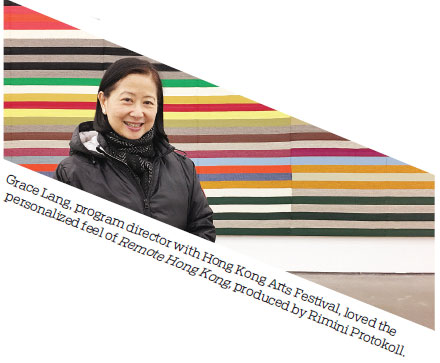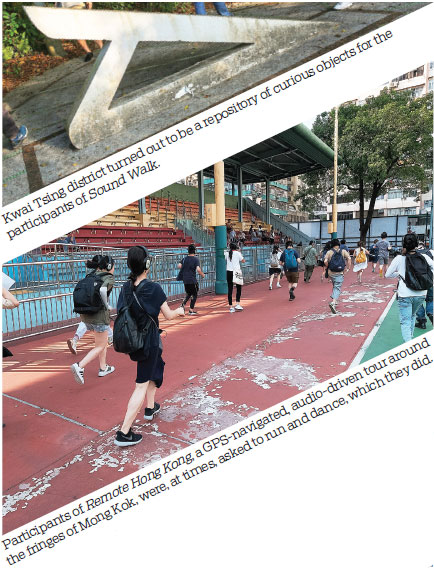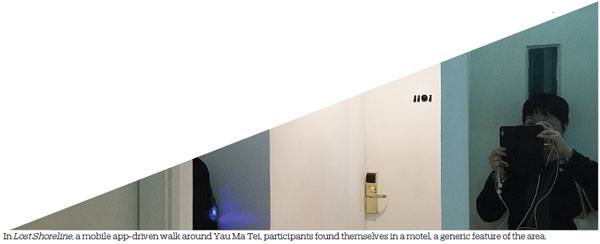One step at a time
Updated: 2018-12-07 07:46
(HK Edition)
|
|||||||||
Customer focus seems to drive new art in HK. In Part 1 of a series on the growth of immersive and interactive art forms, Chitralekha Basu checks out a range of cultural tours that require active engagement from participants.
Janet Chung, a keen watcher of new cultural events in the city, had signed up for Sound Walk, an immersive experiential tour designed by the Hong Kong-based arts collective, soundpocket. The piece was commissioned by New Vision Arts Festival, Leisure and Cultural Services Department's bi-annual showcasing of fresh work by talented local and overseas artistes which ended in November.
The show placed the participants in a simulated crisis situation. They were assigned by the "bureau of reconstruction" representatives to conduct a survey in a village that had been marked for redevelopment. The group walked to the chosen destination in a rural part of Kwai Tsing district, meeting "villagers" who appeared extremely worried in the face of an impending displacement. They were not sure if the compensation on offer would be enough to help them start over. Besides they couldn't bear to imagine ghastly tower blocks coming up on what had traditionally been agricultural land nurtured by their ancestors.
"When we met again at the end of the day and appealed to the 'reconstruction bureau' staff on behalf of the villagers, they heard us out but refused to take our suggestions. Their leader said, given other considerations, they would have to go ahead with redeveloping the village," says Chung. "We knew both the 'villagers' and the 'reconstruction bureau' staff were only actors playing a role, and yet we got so caught up in the moment, we were genuinely upset."
And that's when the arts administrator in her kicked in.
"Immersive experiences such as these are a very powerful tool," says Chung, who is an LCSD staffer but in this case wasn't involved in an official capacity. "People who do not get too enthused by the prospect of going to the theater might still want to join a tour. As arts administrators it is perhaps our duty to make use of this tool to get people to join in greater numbers, make these shows more frequent and of a better quality, so that the audiences come back to see them. Shows like these might arouse their interest in regular theater."
Chung's story would have pleased festival curator Alex Cheung. "As our festival title suggests, we'd like to open up newer ways of looking at things, and that could apply to just about anyone (and not necessarily the initiated audience)," says Cheung. "In a mature economic entity like Hong Kong we need infusion of new energy to do newer things in the field of culture."
Talking to me?
While cultural walks are not exactly new in Hong Kong, the tilt these days is towards presenting a more personalized experience to the consumer. Participants still move in a group but often they are required to have their eye on the monitor of a smart electronic device and receive instructions through an audio feeding into their headsets.
Cheung, who commissioned two outdoor shows for the festival - the other being How I Learned to Do Bad Drifting by HerStory Polygon - said he wanted them to be different in tone and tenor and yet resonate with each other. In Bad Drifting, headset-wearing participants equipped with a smart device were put in a car and wheeled around the urban areas of Kwai Tsing. They got to see the Tsing Ma Bridge from an unusual angle and stopped on top of a hill where they could take a moment to observe the placid expanse of the South China Sea.
"This one was more personal, conjuring up memories of family, parents, childhood dreams as one listened to the audio feed," says Cheung. "It was more poetic."
What consumers of experiential tours do not always realize is that when the seemingly omniscient voice on the other side of their audio feed asks them to choose between two paths, often what they get is a Hobson's choice. In fact, the choice has already been made on their behalf, based on research in human psychology and behavioral patterns.
Grace Lang, program director with Hong Kong Arts Festival, has designed a few guided cultural tours, most notably around the spiritually-informed compositions by Bach and their resonances with church architecture in Hong Kong. She went on the Remote Hong Kong walk, a sophisticated GPS-navigated, audio-driven tour designed by Rimini Protokoll from Berlin, and brought to the city in August by Tai Kwun Centre of Heritage and Arts.
Lang says she loved the tour's personalized feel. "It was very good because there were leading questions for one to ponder upon, and a scope for running and dancing around," she says. "At one stage one was asked to choose one's path. Then we all ended up in the same place anyway."
Cheung agrees that although it was made to look like the participants in Bad Drifting were in a conversation by keying in responses to questions on their smart device, their experience at the end of the day more or less conformed to a script. Nonetheless, no one has asked for their money back yet.
Lang says Remote Hong Kong was a welcome departure from the old-style guided cultural tours that were "more communal". The show was a huge hit and made for a talking point in Hong Kong's cultural circles. Somewhat disconcertingly for Tai Kwun's director of performance art, Eddy Zee, there were a few knock-off local versions immediately afterwards. "They have borrowed the format, but the finesse and technology of Remote Hong Kong would be difficult to match," says Zee.
Fact and fiction
Indeed, Remote Hong Kong is based on a model that has been tried and tested in around 40 cities across the world. So Hong Kong artists who would like their walks to really talk to the audience (and not necessarily by adopting the commanding, exhorting tone that Remote Hong Kong did at times) should probably try to find their own voice.
Cheung says there are signs of that happening. "More and more local groups are capable of efficiently handling such shows," he says. It was the reason he opted for commissioning two new pieces rather than importing a time-tested model.
Chung is not as enthusiastic. "The state of immersive walks in Hong Kong is still in its infancy. We need to learn quality control and manage audience expectations," she avers.
However, she would give a thumbs up to Lost Shoreline by Rooftop Productions, a mobile-app driven walk where participants explore the older areas of Yau Ma Tei on their own and get to choose from a range of theater experiences afterwards. Chung also recommends the journey of the isle designed by the theatre du pif duo Bonni Chan and Sean Curran as it allowed participants to freely leave and rejoin a guided walk across Cheung Chau island, "like in a hop-on, hop-off tourist bus".
"We met very interesting people, including a former Cantonese opera performer who showed us a few moves," recalls Chung. "I thought the blending of playacting, history and real-life stories was very well executed."
Through young eyes
Walks could become especially meaningful when familiar locations are viewed through new lenses. The architect Anthony Lai led a group of students from Po Leung Kuk Lee Shing Pik College on a walk around their school in Tsuen Wan. They went up on the terrace of an industrial building and visited an abandoned wet market among other places. Lai was pleasantly surprised by the originality displayed in some of the photographs the students took. He mentions an image that clicked with him particularly well.
"It's a photo taken with a hand hanging out from the window, looking down with a single- point perspective setting," says Lai. "The student did a good job in capturing a photo with an angle that is not common to see in everyday life. The window frames in their semi-opened position, together with the structure of the building creates a sense of illusion whereby the wall becomes floor. The image offers a lot of multiple readings."
Lai is making a video out of the photos taken by the students during the walk. It will serve as the backdrop of the Hong Kong Episodes concert in January 2019. Developed as part of the Jockey Club New Arts Power initiative, the event is a tribute to life in Hong Kong on a typical day, created by Lai and the musicians Fung Lam and Teriver Cheung.
Lai says the experience of discovering Hong Kong anew in the company of young people has been edifying. "I'm inspired by how the students think and see things so purely without limits and constraints," he says.
Mind the gap
One wouldn't have thought there was much left to discover by walking around in downtown Hong Kong, but it seems someone had a different idea. In February 2019, Hong Kong Arts Festival will present Choreography Walk. Those who sign up will take a walk "from Hollywood Road Park, and down Soho, the Mid-levels and Central, all the way to Pier 7," says the event's choreographer Justine A. Chambers.
The pace they are expected to keep will be nothing like what the swarming office-going crowd who walk that route on a regular weekday is used to doing. It will be set at a different rhythm, where walkers engage with the surroundings more mindfully, based on a new awareness of "how architecture, topography, urban planning and civic governance work upon our bodies, and in turn how we can activate our individual and collective physical power upon these forces".
Along the way there will be a performance or two, so understated that they might be missed if the walkers weren't totally alert to the surroundings. At the same time it's required that "the participants move as an ensemble with an awareness of each other and work towards staying together," notes Chambers.
Between walks that can make participants feel special in a group to those in which the feeling of being part of a group is special, curated walks in Hong Kong seem to be heading in a new direction.
Contact the writer at
basu@chinadailyhk.com





(HK Edition 12/07/2018 page10)